Cataracts
What does cataract surgery involve? Information on the causes, symptoms, and treatment of this visual impairment.
Symptoms and Causes
Cataracts occur when the normally transparent lens becomes opaque. As a result, vision becomes blurred and significantly deteriorates. The change in opacity is usually a natural consequence of aging, as the lens gradually loses its ability to focus.
Depending on their nature, there are three different types of cataracts:
- Nuclear cataract: This is the most common type. It affects the central part of the lens, which turns yellowish and may even become brown. It typically begins forming around the age of 50 and fully develops between 70 and 75.
- Cortical cataract: This type appears on the edges of the lens. It usually manifests as whitish streaks on the periphery, which gradually extend toward the center, impairing vision.
- Posterior subcapsular cataract: This type develops at the back of the lens, directly in the path of incoming light. It is more common in younger individuals, who may experience glare or difficulty seeing in bright light.
Visual impairment caused by cataracts progresses gradually, so in the early stages, it can often be corrected with glasses. However, when the condition worsens to the point of interfering with daily life, surgery is required to remove the cataract.
Symptoms
The main symptoms of cataracts include:
- Blurred or cloudy vision.
- Photosensitivity.
- Altered color perception, usually appearing less intense.
- Light halos.
- Glare.
- Increased difficulty seeing at a distance.
Causes
Although cataracts are most commonly caused by aging, they can also develop for other reasons:
- Senile cataract: The most common type, caused by the natural aging of the eye.
- Traumatic cataract: Resulting from an injury or as a consequence of surgery.
- Radiation-induced cataract: Caused by exposure to ionizing radiation.
- Congenital cataract: Present at birth or developing during childhood. It may be due to genetic factors, trauma, or infections contracted during pregnancy.
Risk Factors
The main factors that increase the likelihood of developing cataracts include:
- Aging.
- Diabetes.
- Smoking.
- Excessive alcohol consumption.
- Hypertension.
- Eye trauma.
- Eye surgery.
- Radiation exposure.
- Long-term corticosteroid use.
Complications
If left untreated, cataracts can lead to complete vision loss. However, this type of blindness is reversible in most cases, as it can be corrected through surgery.
Prevention
There is no known way to prevent cataracts from forming. However, early detection is recommended by:
- Attending regular ophthalmologic check-ups.
- Quitting smoking.
- Reducing alcohol consumption.
- Maintaining a healthy diet.
Which Doctor Treats Cataracts?
Cataracts are diagnosed and treated by ophthalmologists. Geriatricians and family doctors can also detect them.
Diagnosis
Cataracts can be diagnosed during a routine eye examination. The tests commonly performed include:
- Slit-lamp examination: Allows detailed observation of the eye's structures. The patient rests their chin on a support and looks at a light inside the device without blinking.
- Retinal examination: Dilating eye drops are used to examine the retina and assess the characteristics of the cataract.
Treatment
Surgery is the only treatment for cataracts, as no medication can dissolve them or slow their progression. The most common procedure is phacoemulsification, which uses ultrasound to break up the cataract before removing it along with the lens through a small incision. An intraocular lens is then implanted, which may include prescription power if needed.
Cataract surgery does not require general anesthesia, as anesthetic eye drops are used to numb the eye. The procedure lasts about 15 minutes and is usually performed on different days for each eye.
Recovery time varies from person to person, but most patients regain clear vision within a few hours after the surgery. During the postoperative period, patients should avoid sudden movements and strenuous physical activity, and they must use anti-inflammatory eye drops.


































































































